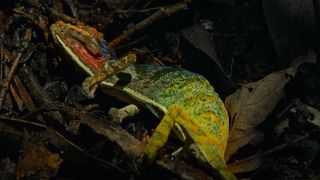Watch chameleon erupt in color 'as if uttering her last words' in her final moments before death
Footage of Labord's chameleon in last moments of her short life shows her skin burst into 'chaotic technicolor patterns' — a spectacle never observed in the wild before.
In dramatic new footage, a chameleon erupts in stunning colors while in the throes of death. Using time-lapse photography, researchers captured the colorful last few hours of the reptile's short life — and the remarkable changes that took place in that time.
"In her last moments, her skin erupts with color, as if uttering her last words," narrator Bumper Robinson said in the clip.
The Labord's chameleon (Furcifer labordi) was filmed in the Kirindy Forest in western Madagascar. This species has one of the shortest known life spans of any four-legged vertebrate, living just four to five months after hatching; they spend longer developing inside an egg (around eight to nine months) than they do outside it.

In the new PBS series "Big Little Journeys," filmmakers followed the female Labord's chameleon as she laid her eggs and covered them with sand to protect them from the effects of the approaching dry season.
Related: Pangolin courtship ritual and birth of a 'pangopup' captured in incredible, rare footage
"The females put all their energy into producing eggs that need to get through the long drought while underground," series producer Valeria Fabbri-Kennedy and scientist Chris Raxworthy, a herpetologist at the American Museum of Natural History, told Live Science in an email. "They die within just a few hours of having laid them, as they have few resources left."
The team had hoped to capture the full life cycle of this little-known species — and realized one individual "had slowed and seemed to be fading," they said. They set up a time-lapse camera, and when they returned two hours later, they found the chameleon dead.
Sign up for the Live Science daily newsletter now
Get the world’s most fascinating discoveries delivered straight to your inbox.
"On reviewing the footage, we were amazed and moved by the colorful spectacle they had filmed — something that the scientists have never observed in the wild before," Fabbri-Kennedy and Raxworthy said.
Chameleons' skin changes color by expanding and contracting special cells that contain nanocrystals — a process that alters how they reflect light. In the clip, the chameleon's skin twinkles and changes color like a fireworks display.
"During death, nervous signals continue to transmit and to change the shape of the skin cells, creating the chaotic technicolor patterns that were captured," Fabbri-Kennedy and Raxworthy said.
This extreme survival strategy of programmed death — in which females die after laying eggs — is seen in many other species, including octopuses and moths.
Among Labord's chameleons, the males also die before the dry season arrives, having expended all their resources fighting for the chance to reproduce. This means that for two-thirds of the year, the entire population exists in eggs buried underground. "Adults have not evolved to survive it [the dry season]," Fabbri-Kennedy and Raxworthy said.

Hannah Osborne is the planet Earth and animals editor at Live Science. Prior to Live Science, she worked for several years at Newsweek as the science editor. Before this she was science editor at International Business Times U.K. Hannah holds a master's in journalism from Goldsmith's, University of London.
Most Popular

